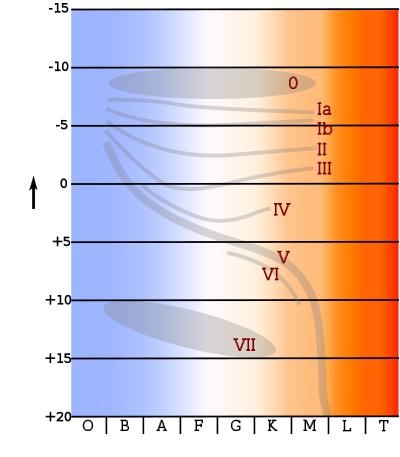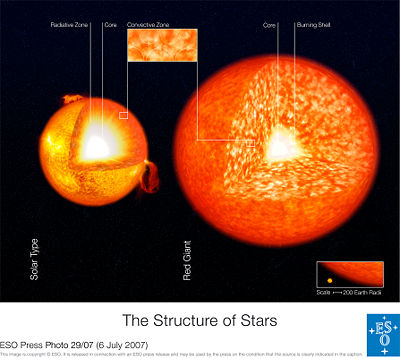Giant star
A giant star is a star with substantially larger radius and luminosity than a main sequence star of the same surface temperature. It is, therefore, placed above the main sequence group in the Hertzsprung-Russell diagram. A giant star is thought to represent an intermediate state in the evolution of a star. After all the hydrogen available for nuclear fusion at the core of a main sequence star has become depleted, the star swells up to a much larger size and becomes a giant star.
Stars of greater luminosity than giant stars are classified as supergiants and hypergiants.
Characteristics
Typically, giant stars have radii between 10 and 100 solar radii and luminosities between 10 and 1,000 times that of the Sun.[1] Stars still more luminous than giants are referred to as supergiants and hypergiants.[2][3] A hot, luminous main sequence star may also be referred to as a giant.[4] Apart from this, because of their large radii and luminosities, giant stars lie above the main sequence (luminosity class V in the Yerkes spectral classification) on the Hertzsprung-Russell diagram and correspond to luminosity classes II or III.[5]
Formation
A star becomes a giant star after all the hydrogen available for fusion at its core has been depleted and, as a result, it has left the main sequence.[5] A star whose initial mass is less than approximately 0.4 solar masses will not become a giant star. This is because such stars have their interior thoroughly mixed by convection and therefore continue fusing hydrogen until it is exhausted throughout the star, at which point they become white dwarfs, composed chiefly of helium. This exhaustion, however, is predicted to take significantly longer than the lifetime of the Universe up to now.[6]
If a star is more massive than this lower limit, then when it consumes all of the hydrogen in its core available for fusion, the core will begin to contract. Hydrogen now fuses to helium in a shell around the helium-rich core, and the portion of the star outside the shell expands and cools. During this portion of its evolution, labeled the subgiant branch on the Hertzsprung-Russell diagram, the luminosity of the star remains approximately constant and its surface temperature decreases. Eventually the star will start to ascend the red giant branch on the Hertzsprung-Russell diagram. At this point the surface temperature of the star, now typically a red giant, will remain approximately constant as its luminosity and radius increase drastically. The core will continue to contract, raising its temperature.[7]
If the star's mass, when on the main sequence, was below approximately 0.5 solar masses, it is thought that it will never attain the central temperatures necessary to fuse helium.[8] It will therefore remain a hydrogen-fusing red giant until it eventually becomes a helium white dwarf.[7] Otherwise, when the core temperature reaches approximately 108 K, helium will begin to fuse to carbon and oxygen in the core by the triple-alpha process.[7] The energy generated by helium fusion causes the core to expand. This causes the pressure in the surrounding hydrogen-burning shell to decrease, which reduces its energy-generation rate. The luminosity of the star decreases, its outer envelope contracts again, and the star leaves the red giant branch.[9]
Its subsequent evolution will depend on its mass. If not very massive, it may be found in the horizontal branch on the Hertzsprung-Russell diagram, or its position in the diagram may move in loops.[7] If the star is not heavier than approximately 8 solar masses, it will eventually exhaust the helium at its core and begin to fuse helium in a shell around the core. It will then increase in luminosity again as, now an AGB star, it ascends the asymptotic giant branch of the Hertzsprung-Russell diagram. After the star sheds most of its mass, its core will remain as a carbon-oxygen white dwarf.[7]
For main-sequence stars with masses great enough to eventually fuse carbon (approximately 8 solar masses)[7] this picture must be modified in many ways. These stars do not increase greatly in luminosity after leaving the main sequence, but they will become redder. They may become red supergiants, or mass loss may cause them to become blue supergiants.[10][2] Eventually, they will become white dwarfs composed of oxygen and neon, or will undergo a core-collapse supernova to form neutron stars, or black holes.[7]
Examples
Well-known giant stars of various colors include the following:
- Alcyone (η Tauri), a blue-white (B-type) giant,[11] the brightest star in the Pleiades.[12]
- Thuban (α Draconis), a white (A-type) giant.[13]
- σ Octantis, a yellow-white (F-type) giant.[14]
- α Aurigae Aa, a yellow (G-type) giant, one of the stars making up Capella.[15]
- Pollux (β Geminorum), an orange (K-type) giant.[16]
- Mira (ο Ceti), a red (M-type) giant.[17]
See also
- Hertzsprung-Russell diagram
- Hypergiant
- Main sequence
- Nuclear fusion
- Red giant
- Star
- Supergiant
Notes
- ↑ Patrick Moore, "Giant star," in Astronomy Encyclopedia (New York, NY: Oxford University Press, 2002, ISBN 0195218337).
- ↑ 2.0 2.1 David Darling, Supergiant, The Encyclopedia of Astrobiology, Astronomy, and Spaceflight. Retrieved December 14, 2008.
- ↑ David Darling, Hypergiant, The Encyclopedia of Astrobiology, Astronomy, and Spaceflight. Retrieved December 14, 2008.
- ↑ Jacqueline Mitton, "Giant star," in Cambridge Dictionary of Astronomy (Cambridge, UK: Cambridge University Press, 2001, ISBN 0521800455).
- ↑ 5.0 5.1 John Daintith and William Gould (eds.), "Giant," in The Facts on File Dictionary of Astronomy, 5th ed. (New York, NY: Facts On File, Inc., 2006, ISBN 0816059985).
- ↑ Michael Richmond, Late stages of evolution for low-mass stars. Retrieved December 14, 2008.
- ↑ 7.0 7.1 7.2 7.3 7.4 7.5 7.6 Maurizio Salaris and Santi Cassisi, Evolution of Stars and Stellar Populations (Chichester, UK: John Wiley & Sons, Ltd., 2005, ISBN 047009219X).
- ↑ S.O. Kepler and P.A. Bradley, Structure and Evolution of White Dwarfs, Baltic Astronomy 4: 166–220. Retrieved December 14, 2008.
- ↑ Robin Ciardullo, Giants and Post-Giants. Retrieved December 14, 2008.
- ↑ T.W. Hartquist, J.E. Dyson, and D. P. Ruffle, Blowing Bubbles in the Cosmos: Astronomical Winds, Jets, and Explosions (New York, NY: Oxford University Press, 2004, ISBN 0195130545).
- ↑ Simbad, Alcyone. Retrieved December 14, 2008.
- ↑ Jim Kaler, Alcyone, STARS. Retrieved December 14, 2008.
- ↑ SIMBAD, Thuban. Retrieved December 14, 2008.
- ↑ SIMBAD, Sigma Octantis. Retrieved December 14, 2008.
- ↑ SIMBAD, α Aurigae Aa. Retrieved December 14, 2008.
- ↑ SIMBAD, Pollux. Retrieved December 14, 2008.
- ↑ SIMBAD, Mira. Retrieved December 14, 2008.
ReferencesISBN links support NWE through referral fees
- Daintith, John, and William Gould (eds.). The Facts on File Dictionary of Astronomy, 5th ed. New York, NY: Facts On File, Inc., 2006. ISBN 0816059985.
- Hartquist, T.W., J.E. Dyson, and D. P. Ruffle. Blowing Bubbles in the Cosmos: Astronomical Winds, Jets, and Explosions. New York, NY: Oxford University Press, 2004. ISBN 0195130545.
- Mitton, Jacqueline. Cambridge Dictionary of Astronomy. Cambridge, UK: Cambridge University Press, 2001. ISBN 0521800455.
- Moore, Patrick (ed.). Astronomy Encyclopedia. New York, NY: Oxford University Press, 2002. ISBN 0195218337.
- Salaris, Maurizio, and Santi Cassisi. Evolution of Stars and Stellar Populations. Chichester, UK: John Wiley & Sons, Ltd., 2005. ISBN 047009219X.
External links
All links retrieved June 21, 2017.
- Giant Stars. Genesis Fact Sheet.
- Interactive giant star comparison.
Credits
New World Encyclopedia writers and editors rewrote and completed the Wikipedia article in accordance with New World Encyclopedia standards. This article abides by terms of the Creative Commons CC-by-sa 3.0 License (CC-by-sa), which may be used and disseminated with proper attribution. Credit is due under the terms of this license that can reference both the New World Encyclopedia contributors and the selfless volunteer contributors of the Wikimedia Foundation. To cite this article click here for a list of acceptable citing formats.The history of earlier contributions by wikipedians is accessible to researchers here:
The history of this article since it was imported to New World Encyclopedia:
Note: Some restrictions may apply to use of individual images which are separately licensed.

